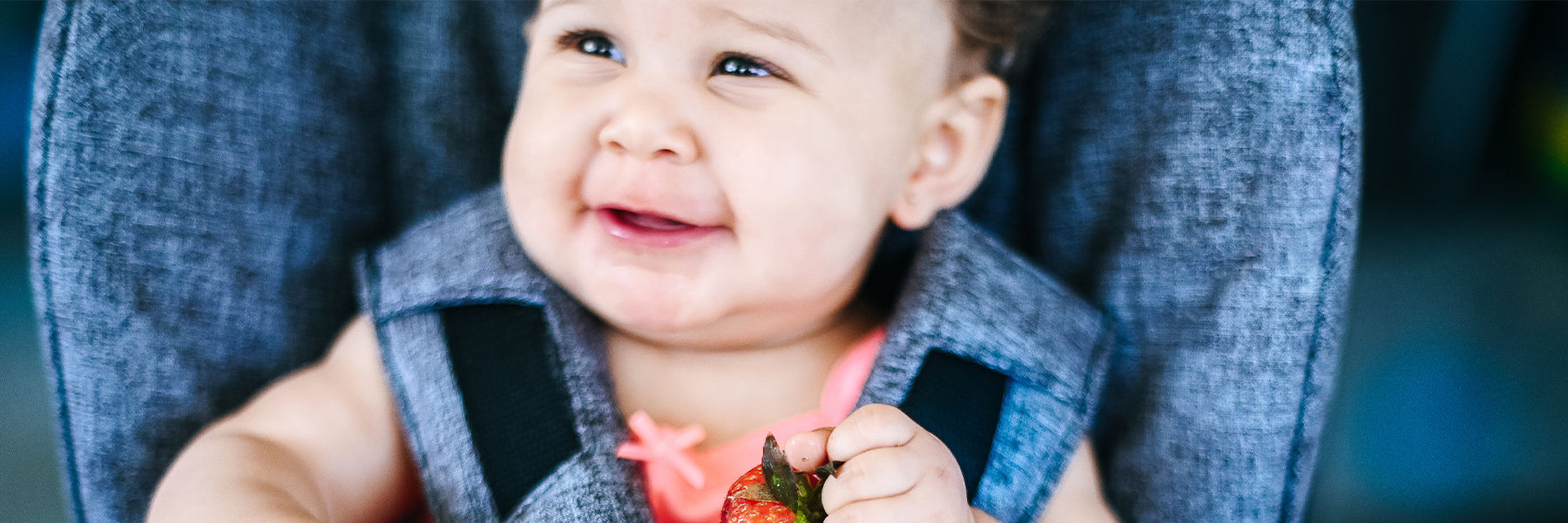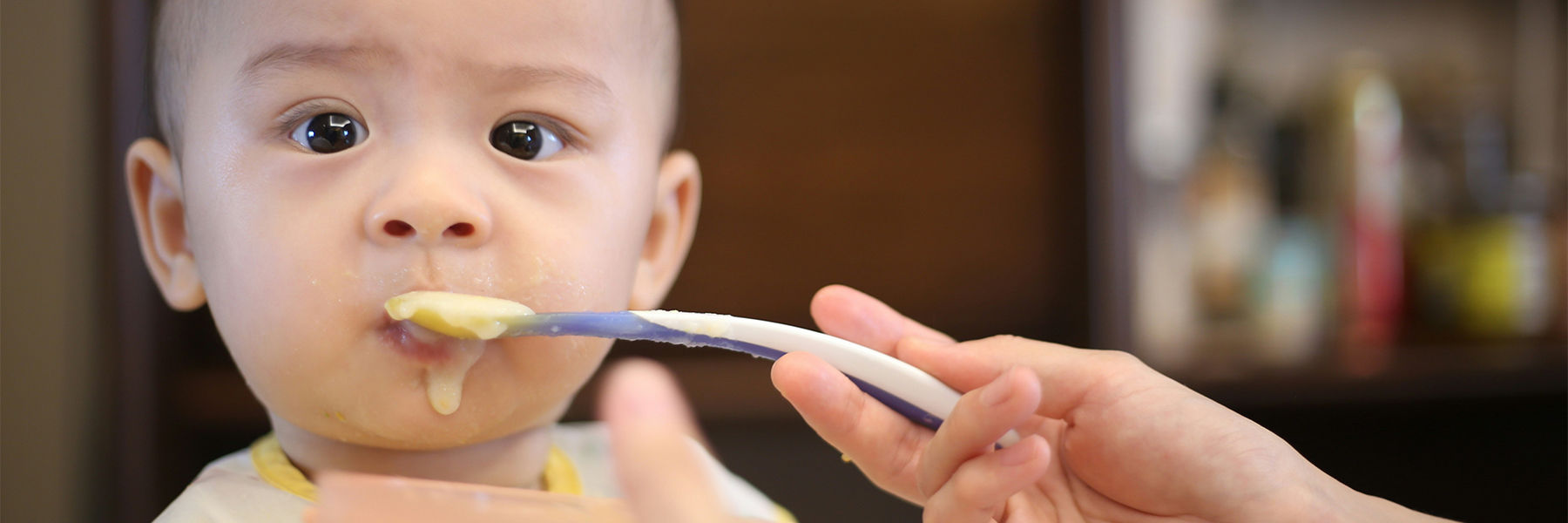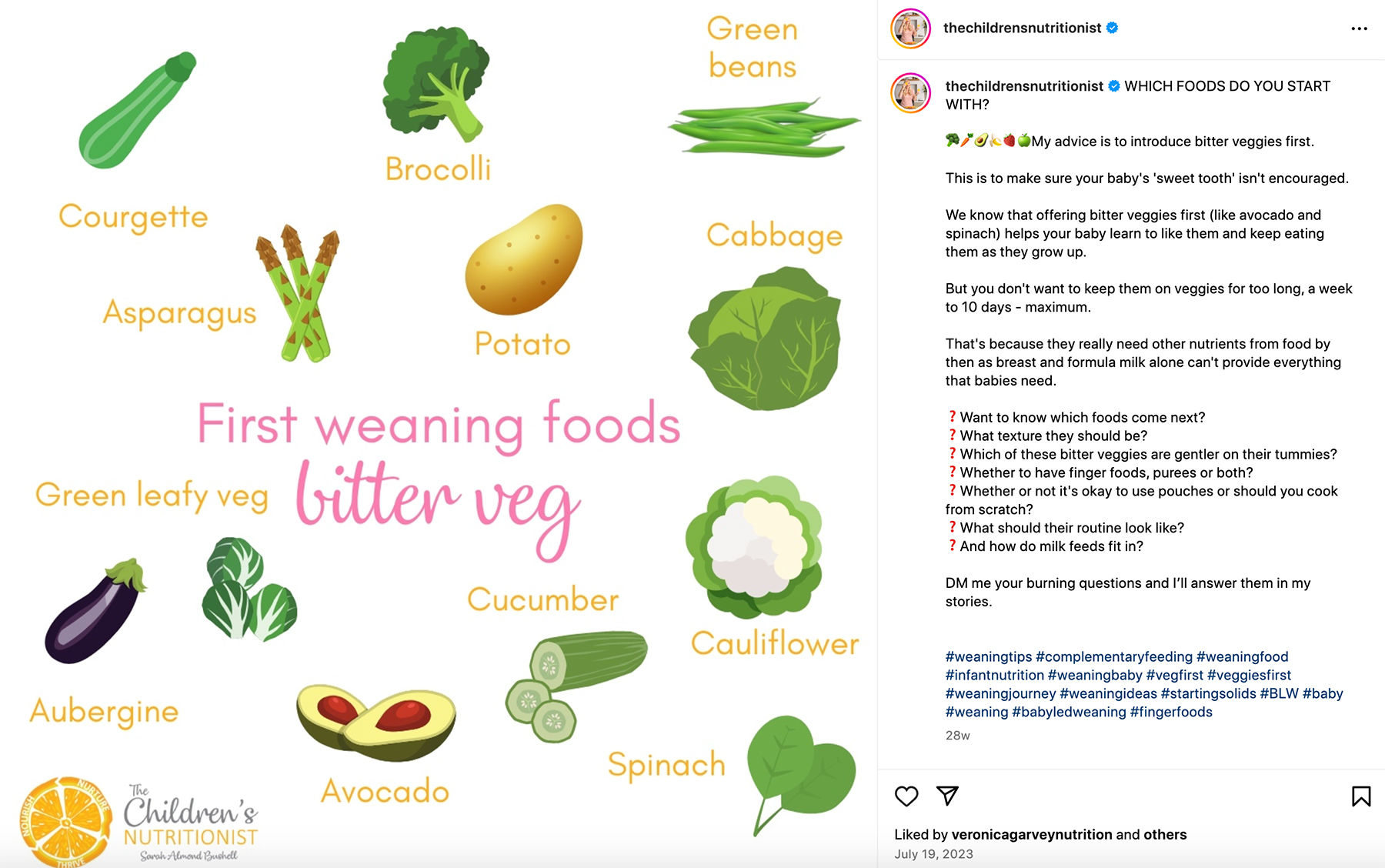Use arrow keys to navigate through the menu items. Use Tab key to navigate through the menu banners.
Baby Led Vs Purees

Baby Led Vs Purees
Registered Dietitian Sarah Almond Bushell is here to guide you through both methods
When your little one is ready to start eating solid foods, you might wonder whether to try baby-led weaning or go with traditional purees. This is a big step for your baby, and it's not just about food – it's about helping them grow and learn. Let's explore these two options.
What is baby-led weaning (BLW)?
Baby-led weaning means letting your baby feed themselves solid food, right from the start. You simply offer them pieces of food, and they pick up and eat what they like. This method has been popular since the early 2000s and it’s all about letting your baby take charge of their eating. Instead of making special baby food, you can give them bits of food you cook for the family. It's a hands-on way for your baby to explore food.
What is traditional spoon weaning?
With traditional weaning, you start by feeding your baby pureed food with a soft baby spoon. At first, babies can only manage very smooth purees, but as they get better at eating, they can manage thicker textures and lumps. It's a gradual process that includes introducing finger foods alongside purees at around six and a half months. As your baby gets older, the texture of the purees becomes thicker and chunkier to match their progressing development.

Choosing between BLW and purees
When deciding how to start weaning, think about what feels right for you and your baby. If you want to go for baby-led weaning, it’s essential to wait until they're six months old (even though you think they might be ready earlier) to ensure they can handle different textures safely. The NHS recommendation is to start weaning at around six months, but if you intend to start before your baby is six months, then purees are the way to go.
Start off with veggies
Whichever method you choose, offer your baby vegetables before other foods. Research shows that babies who try vegetables first are more likely to enjoy them as they grow up. Start with single vegetables at each meal and repeat them often. Begin with less sweet veggies like spinach, broccoli, or courgette, and then introduce sweeter ones like butternut squash or carrot.
You only need to introduce veggies for a week to ten days. After that, your baby needs a variety of different nutrients.

Find Sarah’s Instagram account @thechildrensnutritionist
Next foods
Babies don’t eat very much at first, especially with baby-led weaning. Therefore, it's important to move on to nutritious foods after veggies. Good options include:
-
Eggs – cooked any way. Try scrambled, hard-boiled then mashed, or an omelette cut into fingers.
-
Full-fat natural yoghurt – choose either Greek or plain yoghurt but avoid fruit-flavoured yoghurts as these tend to have added sugars that babies don’t need.
-
Dark meat from chicken or turkey – the dark meat is more nutritious with extra iron and energy, which babies need for rapid growth.
-
Oily fish like salmon, trout, mackerel – choose fresh and unsmoked. Slow-cooked beef or lamb – slow cooking makes these highly nutritious meats easier for young babies to chew and swallow.
-
Minced beef shaped into burgers or sausages – this makes highly nutritious finger foods.
-
Buttered toast – anything goes but wholemeal is an easier texture than white for babies in the early stages of weaning.
-
Cheese – any kind. You can grate mozzarella, cut cheddar into sticks, cut feta into cubes, or serve cream cheese as a dip or spread on crackers. Avoid unpasteurised or mould-ripened cheeses as they pose a greater risk of food poisoning.
-
Avocado – rich in vitamin E.
-
Smooth nut butter – you may need to thin this down at the start of weaning with a little of your baby’s usual milk.
-
Steamed sweet potato fingers – packed with starchy carbs and antioxidants.
I also recommend using olive oil in your cooking – you can introduce it right from the start of weaning.
Food textures and safety
Whether you choose BLW or purees, it's important to offer safe foods for your baby to eat. Here are some tips to minimise the risk of choking:
-
Avoid whole nuts. Use smooth nut butters and ground nuts instead. Nut butters are recommended for babies from 6 months to prevent nut allergy.
-
Cut up food that could be choking hazards, like cherry tomatoes or grapes.
-
Avoid hard foods like raw carrots or apples where large chunks could be broken off. You can grate these hard foods instead, so your baby doesn't miss out.
-
Stay away from hard crackers, crisps, or tortilla chips that crumble. Try softer options like melty puffs.
-
Don't give your baby food aimed at older children or adults, such as popcorn, hot dogs, or raw jelly cubes.
Advantages of BLW
Baby-led weaning has several benefits:
-
It helps develop fine motor skills as babies learn to pick up and eat food.
-
It encourages a positive relationship with food, letting babies eat according to their hunger and fullness.
-
It allows for sensory exploration, offering a variety of colours, shapes, tastes, textures, and smells which is how babies learn.
Advantages of puree weaning
Puree weaning also has its perks:
-
It offers more reassurance that your baby has eaten the right balance of nutrition.
-
You can easily transition from smoother to thicker textures as your baby's eating skills improve.
-
Purees are often easier for babies to digest.
-
It's a more controlled way to introduce allergens as you know they’ve eaten the right amount to assess their tolerance.
-
There are a wide variety of ready-made pureed baby foods available for when you don’t have the time or ability to cook.
Foods to avoid
Whichever method you opt for, there are certain foods that babies under 12 months should not have. These are:
-
Honey
-
Mould-ripened soft cheeses and cheeses made with unpasteurised milk
-
Salt, sugar and foods containing added salt and sugar
-
Whole cow’s milk as a main drink (you can use it in other foods)
-
Shark, swordfish or marlin
-
High choking-risk foods such as whole grapes or nuts
-
Chocolate, tea and coffee
-
Highly processed foods such as tins, packets and jar foods made for older children and adults
-
Rice milk drinks
Making weaning affordable
Weaning your baby doesn't have to be expensive. Here are some tips for keeping costs down:
-
Use foods you usually eat. For BLW, offer small portions of the meals you’re cooking anyway and for purees, do the same but blend it up. Just avoid the foods listed above when you’re cooking.
-
Look out for deals at Asda on foods that keep for a long time or can be frozen.
-
Batch-cook and freeze baby-sized individual portions for later.
-
Get creative with leftovers. You can turn last night's dinner into today's baby meal.
Whether you choose baby-led weaning or traditional purees, the most important thing is that your baby starts learning about food and enjoying family mealtimes. Remember, every baby is different, so choose the best method for your family. And it’s totally okay to do a bit of both!
About Sarah
Sarah Almond Bushell is an award-winning Registered Paediatric Dietitian, ex NHS Consultant of 25 years, and founder of The Children’s Nutritionist. Sarah’s mission is to help parents raise their children to be happy healthy eaters right from the start.
Help & Customer service
- Help Centre
- How to shop
- Product recalls
Payment Methodslist with 8 items
- Asda Group of Companies
- Modern Slavery Statement
- Electrical Waste Recycling
- Terms & Conditions
- Customer Review Policy
- Privacy Centre
- Cookie Settings
- Accessibility
© ASDA 2025